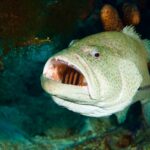Saltwater Fishing for Grouper: Techniques and Tips
Saltwater fishing for grouper can be an exhilarating experience, as these fish are known for their strength and ability to put up a good fight. There are a variety of grouper species found in saltwater, including black, red, and gag grouper. In this article, we will discuss techniques and tips for saltwater fishing for grouper that can help you catch these prized fish.
- Location and Habitat
Grouper can be found in a variety of habitats, including reefs, wrecks, and rock formations. They are typically found in waters ranging from 30 to 300 feet deep. When fishing for grouper, it’s important to understand their habitat and behavior. Grouper are bottom-dwellers and tend to hide in holes or crevices in the reef or rock formations. They are ambush predators, so they often wait for their prey to come to them. Look for structures like ledges, drop-offs, and rocky outcroppings where grouper may be hiding.
- Tackle and Equipment
When fishing for grouper, you’ll need heavy-duty tackle and equipment to handle their size and strength. A strong rod and reel combo, like a 6’6″ to 7’6″ heavy-action rod paired with a conventional reel, will allow you to handle the weight and power of a grouper. Braided line with a high pound test rating, like 80-pound test or higher, is recommended to handle the weight of the fish and the structure they may be hiding in.
For bait, live or cut baitfish are effective, such as mullet, pinfish, or squid. Using a fish finder rig with a circle hook can be a great way to hook and catch grouper. Circle hooks are designed to hook the fish in the corner of the mouth, reducing the chance of a gut hook and increasing the chances of a successful catch and release.
- Techniques
When fishing for grouper, there are a variety of techniques that can be effective. One popular technique is bottom fishing, where you drop your bait down to the bottom and wait for a bite. This can be effective when fishing around reefs or rocky outcroppings. Another technique is trolling with diving plugs or lures. This can be effective when fishing in deeper waters or when targeting larger grouper.
Another effective technique for grouper fishing is using a jig. Jigs are designed to mimic baitfish and can be jigged up and down to attract the attention of grouper. Vertical jigging can also be effective, where you drop a heavy jig to the bottom and then rapidly jig it up and down to attract a strike.
- Timing
The best time of day to fish for grouper is typically early morning or late afternoon, when the water is cooler and the fish are more active. It’s also important to pay attention to the tides and currents, as grouper will often be more active during incoming or outgoing tides. Plan your fishing trip accordingly to maximize your chances of a successful catch.
- Regulations
It’s important to note that there are regulations in place for catching grouper, including minimum size limits and bag limits. It’s important to check with local authorities and regulations before heading out on a grouper fishing trip to ensure that you are fishing within the legal limits.
In conclusion, saltwater fishing for grouper can be an exciting and rewarding experience. Understanding their habitat and behavior, using the right equipment and techniques, and paying attention to timing and regulations can help increase your chances of a successful catch. With a little knowledge and preparation, you can enjoy the thrill of catching these powerful fish on your next saltwater fishing trip.






